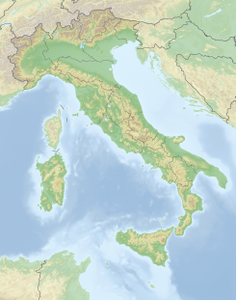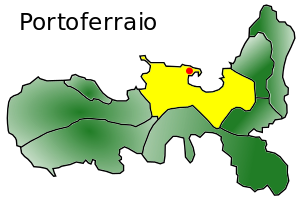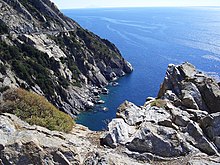Elba
| Elba | ||
|---|---|---|
| Elba and the Tuscan Archipelago | ||
| Waters | Tyrrhenian Sea | |
| Archipelago | Tuscan Archipelago | |
| Geographical location | 42 ° 47 ' N , 10 ° 17' E | |
|
|
||
| surface | 224 km² | |
| Highest elevation |
Monte Capanne 1019 m |
|
| Residents | 32,000 143 inhabitants / km² |
|
| main place | Portoferraio | |
| The municipalities on Elba (capital Portoferraio highlighted) | ||
Elba is an island in the Mediterranean Sea and belongs to the Tuscan Archipelago in the Tuscany region in Italy ( Livorno province ). It is less than ten kilometers from mainland Italy.
Today around 32,000 people live on the island in winter in seven municipalities: Portoferraio (capital of the island, with the island of Montecristo ), Campo nell'Elba (with Pianosa ), Capoliveri , Marciana , Marciana Marina , Porto Azzurro and Rio .
geography
With a coastline of 147 km and a surface area of 224 km², Elba is the third largest island in Italy (after Sicily and Sardinia ). The maximum length of the island in east-west direction is around 27 km, while the maximum distance between the north and south coast is around 18 km. Its highest point is Monte Capanne at 1019 m . The average annual temperature is 15.7 ° C.
history
Antiquity
The oldest people known by name to live on the island of Elba were the Ilvates , a tribe of Ligurian origin. From around 750 BC Elba was increasingly influenced by the Etruscans , who were interested in the extensive iron ore deposits and began to mine them. Around 453 BC The Greeks of Syracuse temporarily occupied Elba; they called the island Aithalia ("the sooty").
246 BC The Romans conquered the island, which belonged to the Roman Empire or its successor kingdoms for around 800 years (from 476 AD, the Odoacer Empire , from 493 Ostrogothic Empire, from 535 Byzantine Empire ). The Romans called the island Ilva.
Elba belonged to the Populonia diocese , established in the 5th century , whose seat was moved to Massa Marittima at the beginning of the 9th century . Elba is still part of this diocese today.
middle Ages
At the end of the 6th century the Lombards came to Elba. Place names of Lombard origin testify to their presence . Possibly Elba or rather the diocese of Populonia as a whole was the subject of the Pippin donation . On the basis of this promise of donation by the Frankish King Pippin, Charlemagne transferred certain parts of the Lombard Empire, conquered in 774, to the Pope until 787 . However, it remains to be said that neither the Pope nor the Margraves were able to repel the Saracen invasions that began in the early 9th century .
In 1015 the Pope commissioned the rising sea power Pisa to protect Elba from the attacks of the Saracens. The Pisans subsequently built many fortifications and watchtowers that are still in existence today; They also built various churches in the Pisan Romanesque style . In the 13th century Elba was repeatedly attacked by Genoa , Pisa's greatest rival.
In 1399, the then ruler Pisas Gherardo Appiano sold the Pisan state to the Duke of Milan Gian Galeazzo Visconti , but held Piombino , the island of Elba and other, smaller areas for himself. In Piombino he then set up an independent signory . In 1442, in agreement with Siena, the island of Elba was assigned to him, so that it subsequently belonged to the Signory Piombino.
Modern times
In 1593, Piombino was elevated to the status of a principality , which in 1635 after the Appiano died out , passed to the Ludovisi by inheritance and later to the Boncompagni by marriage . Portoferraio , which belonged to the Duchy of Tuscany from 1548 , and Porto Longone (today's Porto Azzurro ), which was built by Philip III in 1596 , went a special way . was taken by Spain and then belonged to the Stato dei Presidi .
The island of Elba was temporarily occupied by Great Britain in connection with the Revolutionary Wars and was awarded to France in the Peace of Amiens in 1802 . In the Treaty of Fontainebleau of April 11, 1814, the island was transferred as a sovereign principality to Napoleon , who abdicated on the same day as Emperor of the French . Napoleon landed on Elba on May 4, 1814 and, as ruler of around 10,000 inhabitants, undertook extensive reforms here. On February 26, 1815, however, he fled his exile on the island of Elba and returned to France. In the Congress of Vienna Elba was added to the Grand Duchy of Tuscany and with this in 1860 came to the United Kingdom of Italy .
During the Second World War, the Wehrmacht occupied Elba after the royal Italian troops surrendered on the island after a bombing raid on September 16, 1943. As part of the Italian campaign , the 1st French Army led with British support on 16./17. June 1944 under the code name Operation Brassard the invasion from Elba and liberated the island.
From the 1960s tourism began to develop on Elba, while iron ore mining ended in 1982. In 1996 the Tuscan Archipelago National Park was established, which also includes parts of Elba. The park serves to ensure the sustainable development of marine and land areas in the Tuscan Archipelago.
traffic
Elba can be reached by car ferry from Piombino . From there there are ferry connections to the ports of Portoferraio, Cavo and Rio Marina (municipality of Rio ). A fast ferry from Piombino to Portoferraio takes about 30 minutes. Marina di Campo airport is located in the municipality of Campo nell'Elba .
Attractions
- Napoleon's residence, the Villa San Martino
- Sassi Ritti , menhirs
- Monte Capanne
Web links
Individual evidence
- ^ Gerhard Schreiber : The Italian military internees in the German sphere of influence , Oldenbourg Verlag, Munich 1990, p. 132 ff., Preview in the Google book search
- ↑ Corsica Ferries






